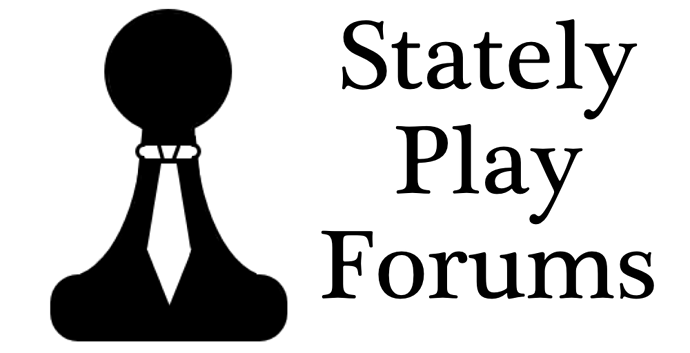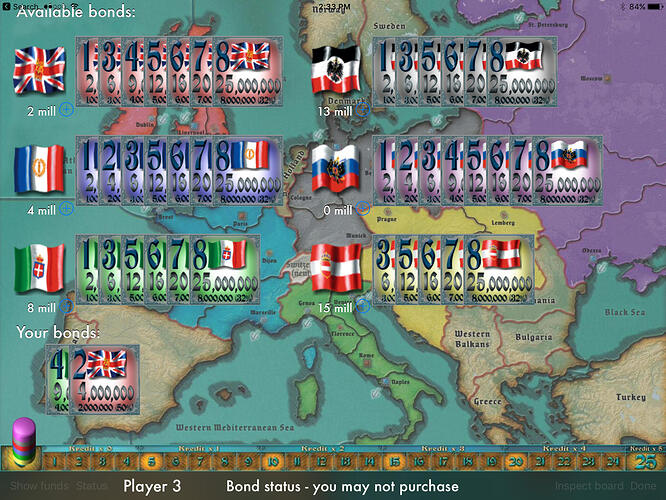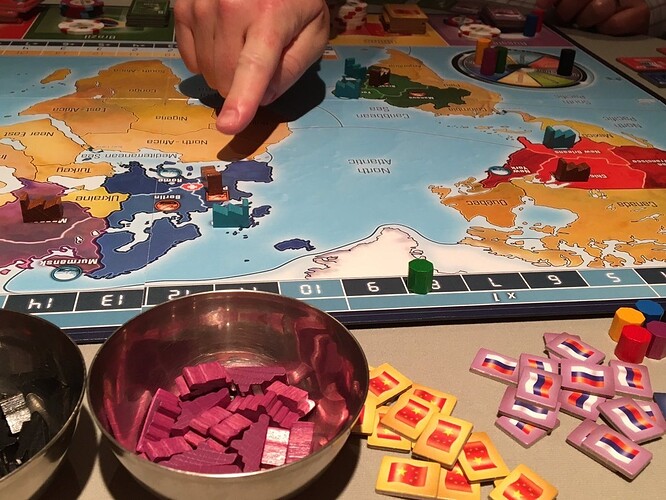Originally published at: http://statelyplay.com/2017/08/03/cardboard-critique-imperial-and-imperial-2030/
Tabletop, iPad •
Mac Gerdts created the board game Imperial way back in 2006 and, while it looked like any other Dudes On A Map title, its theme made it anything but. That theme can best be expressed by something that Elliot says in the first episode of Mr. Robot, “There’s a powerful group of people out there that are secretly running the world. I’m talking about the guys no one knows about, the ones that are invisible. The top 1% of the top 1%, the guys that play God without permission.” Imperial and it’s “sequel”, Imperial 2030, put you in the shoes of the monsters with enough money and power to manipulate the world for their own gain. Oh, and there’s also a rondel.
If you can’t tell, I’m a fan of Imperial, and the theme is a major reason why. While the bits in the game are shaped like warships and cannons and the map of Europe looks ripped straight out of World War I, there’s no battlefield glory or enemies to conquer in the game. Players don’t play a specific nation–such things are beneath people of your stature–instead playing as shadowy agents supplying the warring nations of WWI Europe with cash. You don’t do this out of loyalty or nationalism, this is pure greed.
Nations’ coffers are represented by stocks which you can purchase, with the player holding the most stocks in a nation controlling that nation’s policies on the board. All players holding stock in a company will receive cash when dividends are paid, however, so it never hurts to diversify. It’s possible to own stocks such that you aren’t the majority shareholder in any nation and still win the game. I once cooked an entire steak dinner for my comrades during a game of Imperial, not controlling any nation, and ended up coming in a very close second. That’s not to say that decisions during the game are meaningless, simply that there are many ways to win in Imperial, and being the guy pushing all the bits around the board isn’t necessarily the best way.
[caption id=“attachment_2698” align=“aligncenter” width=“2048”]
Investing in the future[/caption]Gameplay in Imperial centers around Mac Gerdts’ trademark mechanism, the rondel. The rondel is a circular track used to select a nation’s action each turn. Nations can move up to three spaces forward on the track for free, or can pay money to move additional spaces. Only the majority owner of stock in a nation can move that nation’s maker on the rondel, but other shareholders have an interest in that nation doing well, so are usually happy to voice their opinion of what Dear Leader should do.
The value of a nation increases as neutral territories are controlled, but troops and ships cost money, dragging your net worth back down. Thus, there’s a careful balance of wanting to conquer new territory while conscripting the fewest soldiers to do the task. These neutral territories are coveted by all nations, however, so you can expect them to change hands often if left undefended. Notice I didn’t mention anything about conquering the other nations. You can move units into one of the other nations, but you gain nothing from this other than preventing that nation from producing units in that territory. It’s usually not worth it.
[caption id=“attachment_2699” align=“aligncenter” width=“2048”]
Kiss your Balkans goodbye[/caption]Imperial 2030 is another version of Imperial set in a future that looks a bit more like 2017 than 1917. Instead of the six nations being European powers, in 2030 we get Russia, USA, Brazil, India, China, and the EU and the map is expanded to make the game a global affair. The rules are nearly identical, with the few changes feeling more like variants to the original game (and there are even variants in the rulebook to revert to the original rules). The big difference is the map. In Imperial, your entire world is Europe, meaning that nations are bumping heads immediately and neutral territories are immediately fought over. 2030 spreads the neutral areas out, making it feel less confrontational. I’m not sure that it actually is less confrontational, but it feels like it, if that makes any sense.
I enjoy both versions of the game, but lean toward the original Imperial if I had to pick a favorite. Being the power behind the throne seems less depressing when talking about WWI rather than an upcoming WW3 and I’ve also had the original Imperial for far longer than 2030, which makes it feel like a comfortable pair of slippers when it hits the table.
[caption id=“attachment_2700” align=“aligncenter” width=“1200”]
Why is this finger in all my board game pics?[/caption]If you’re not into scouting for the cardboard versions of these classics, there is a digital version. It’s not nearly as polished as some current board game apps–it hasn’t been updated since 2013–but it’s still a really great way to play Imperial solo. The AI is even a worthy opponent, so you won’t cry too much about a lack of multiplayer. If you’re worried about the App-ocalypse taking Imperial off the App Store, the developer has told us that it will be updated to 64- bit and a new version is also in the works. Color me excited.
I got the hankering to write about Imperial after reading an article written by friend-of-the-site, Matt Thrower, over at Pocket Gamer. He mentioned Imperial as a board game app that most people aren’t aware of, and that’s a crime. Imperial is one of the greatest board games ever designed and it deserves to be on your shelf, whether that’s stacked with your other tabletop games or on your iPad.






 I can afford the $ more than the time, but 10 is kind of a lot for a board game app comparatively to all the other great games…
I can afford the $ more than the time, but 10 is kind of a lot for a board game app comparatively to all the other great games…